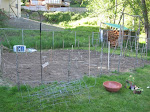Unfortunately there is no archaeological evidence that this is where Golgotha, or Calvary ("The Place of the Skull"), was located during the time of Jesus.
Although the place was known to the Jews as "the house (or place) of stoning" and a possible location for the stoning of Stephen, it was never used as a site of veneration by early Christians. During the Crusades, it was used by the Europeans as a stables. In 1842, a German scholar found this skull-like rock face and suggested it as a site of Jesus' crucifixion. While Golgotha was called "The Place of the Skull" it never says in the Bible that it looked like a skull or that Jesus was crucified on a hill.
In the early 1880s, British Major-General Charles Gordon visited the site and advocated it passionately as the site of Golgotha rather than the Church of the Holy Sepulchre. This was based mostly on the fact that it resembled a skull and was outside the city walls like stated in the Bible. Later it was discovered that the Sepulchre site was inside the walls of Jerusalem during the time of Jesus.
an old picture of the site
due to erosion, the site no longer resembles a skull and
may not have during the time of Jesus
It was still one of the most beautiful and peaceful spots we visited. Afterwards we had Maqluba, or "upside down", for lunch. It was a popular dish we had more than once while there. It is chicken and vegetables and rice steamed in layers in a large pot and flipped upside down onto a serving platter before eating.
























No comments:
Post a Comment